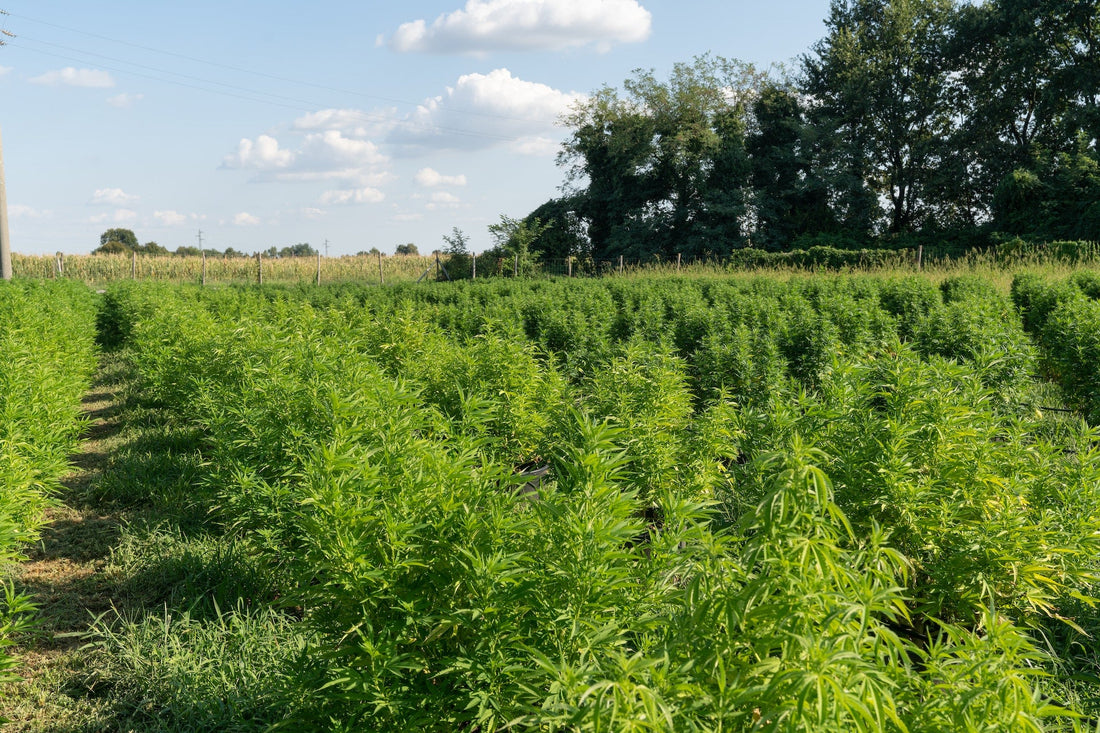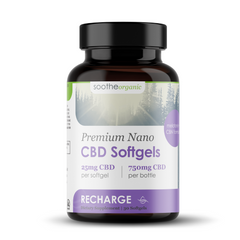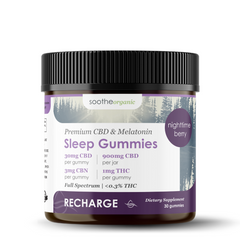Introduction
The hemp industry is thriving, with the global market expected to soar to USD 30.24 billion by 2029, driven by a compound annual growth rate (CAGR) of 22.4% (MarketsandMarkets). This growth is largely due to the rising popularity of cannabidiol (CBD), a non-psychoactive compound derived from hemp, known for its potential to ease pain, anxiety, and inflammation. From CBD cream for pain relief to CBD gummies for joint pain and arthritis, CBD products have captured the attention of wellness seekers worldwide. At Soothe Organic, we take pride in delivering premium CBD products crafted with care. But how does CBD go from a humble hemp plant to the products on your shelf? Let’s dive into this fascinating journey, sprinkled with fun facts, like the fact that the U.S. Declaration of Independence was drafted on hemp paper (WAMA Underwear)!
Cultivation of Hemp
The journey begins on the farm, where hemp plants are carefully cultivated. Hemp is a versatile crop that thrives in well-drained, nutrient-rich soil with ample sunlight and moderate rainfall (USDA). Farmers plant high-quality seeds with low THC (tetrahydrocannabinol) content—less than 0.3% in the U.S.—to comply with regulations. Did you know that hemp was used to make ropes and sails for ships centuries ago, thanks to its durable fibers (National Hemp Association)? Today, farmers use advanced techniques like soil moisture sensors and precision irrigation to optimize growth. Regular testing ensures THC levels stay within legal limits, and the plants are harvested when CBD concentrations peak, typically after 100-120 days.

Harvesting and Drying Hemp
Once mature, hemp plants are harvested, focusing on the flowers and leaves where CBD is most concentrated. Harvesting methods vary, from manual cutting to using specialized machinery (Hemp Processing Solutions). Proper drying is critical to prevent mold and preserve cannabinoids and terpenes, the compounds responsible for hemp’s aroma and therapeutic properties. Drying reduces moisture content to around 10%, using methods like air drying or conveyor belt dryers. Maintaining optimal temperature and humidity ensures the hemp retains its potency, setting the stage for high-quality CBD extraction.

CBD Extraction
The dried hemp is then processed to extract CBD, using methods like CO2, ethanol, or hydrocarbon extraction. At Soothe Organic, we use supercritical CO2 extraction, widely regarded as the gold standard for producing clean, potent CBD without harmful solvents (Natural Ways CBD). CO2 extraction uses pressurized carbon dioxide to isolate CBD, leaving behind unwanted plant material. While ethanol extraction is cost-effective, it may introduce chlorophyll, affecting taste (Zebra CBD). Hydrocarbon extraction can yield flavorful extracts but poses safety risks due to flammable solvents (CBD.market). The table below compares these methods:
|
Extraction Method |
Advantages |
Disadvantages |
|---|---|---|
|
CO2 Extraction |
High-quality, safe, no residual solvents |
Expensive equipment, complex process |
|
Ethanol Extraction |
Cost-effective, scalable, captures broad compounds |
Possible chlorophyll contamination, flammable |
|
Hydrocarbon Extraction |
High potency, flavorful extracts |
Safety risks, environmental concerns |
Post-Extraction Refinement
After extraction, the CBD undergoes refinement to enhance purity. Winterization removes lipids and waxes, while decarboxylation activates CBD by converting CBDA into its therapeutic form (ACS Laboratory). Distillation further purifies the extract, isolating specific cannabinoids for consistent potency. These steps ensure that products like Soothe Organic’s CBD oil softgels deliver reliable results. Research highlights the importance of these processes for creating safe, effective CBD products (Pharmstrong).

Formulating CBD Products for Wellness
The refined CBD is then formulated into various products tailored to specific needs. At Soothe Organic, we craft our products with precision:
-
CBD Cream for Pain Relief: Blended with natural ingredients to penetrate the skin, offering targeted relief for sore muscles and joints. Studies suggest topical CBD may reduce inflammation in animal models (PMC).
-
CBD Oil Softgels: Provide precise dosing with MCT oil for enhanced absorption, ideal for daily wellness.
-
CBD Tincture for Pain: Allows flexible dosing to manage discomfort, with a neutral taste for easy use.
-
CBD Sleep Softgels: Infused with melatonin to promote restful sleep, supported by anecdotal reports of CBD’s calming effects (Harvard Health).
-
CBD Gummies for Joint Pain and Arthritis: A tasty option with consistent CBD dosing, potentially aiding joint health (The Lancet).
Formulation involves selecting carrier oils like MCT or hemp seed oil and ensuring even CBD distribution, especially in edibles. Fun fact: Hemp seeds contain gamma linolenic acid (GLA), also found in breast milk, which may support joint health (Ministry of Hemp).
Lab Testing and Compliance
Before reaching consumers, CBD products undergo rigorous third-party testing to verify potency and safety. Tests check for cannabinoid content, terpenes, and contaminants like pesticides and heavy metals (Pharmstrong). At Soothe Organic, we provide certificates of analysis (COAs) for transparency, ensuring products meet strict standards. Compliance with regulations, such as child-resistant packaging and accurate labeling, is crucial (IMARC Group). This commitment to quality builds trust and ensures safe products for consumers.
Conclusion
The journey of CBD from farm to market is a complex process involving careful cultivation, precise extraction, and rigorous testing. At Soothe Organic, we’re dedicated to delivering high-quality CBD products like CBD cream for pain relief and CBD sleep softgels to support your wellness journey. While research on CBD’s benefits is ongoing, with mixed findings on its efficacy for pain relief (AAFP), many users find value in its potential. Explore our range of products at Sootheorganic.com to discover how CBD can enhance your well-being, backed by our commitment to quality and transparency.
Key Citations
-
Industrial Hemp Market Trends and Forecast
-
Global Industrial Hemp Market Size and Share
-
Industrial Hemp Market Growth and Analysis
-
Industrial Hemp Market Insights and Trends
-
Industrial Hemp Market Size and Projections
-
Hemp Market Analysis and Growth Drivers
-
Industrial Hemp Market Size and Share Report
-
USDA Hemp Production and Disposition Inquiry
-
Industrial Hemp Market Forecast and Growth
-
Global Hemp Market Size and Forecast
-
CBD for Chronic Pain: Science vs. Marketing
-
Cannabinoids in Management of Difficult Pain
-
Cannabidiol as an Analgesic Component
-
CBD Products and Pain Relief Study
-
CBD Oil for Pain Management and Uses
-
CBD for Chronic Pain: Patient Perspectives
-
Efficacy and Safety of CBD for Pain
-
Cannabidiol: What We Know and Don’t
-
Research Suggests CBD Pain Relief Myth
-
CBD Effectiveness in Treating Chronic Pain
-
CBD Extraction: Which Method is Best?
-
CBD Extraction Methods and Processes Explained
-
CBD Extraction Methods and Processes
-
Most Popular CBD Extraction Methods
-
Best CBD Extraction Method Explained
-
Choosing the Best CBD Extraction Method
-
Best and Safest CBD Extraction Methods
-
Methods of CBD Extraction and Storage
-
11 Cool Facts About Hemp
-
50 Amazing Hemp Facts
-
7 Little Known Fun Facts About Hemp
-
8 Facts About Hemp You Need to Know
-
19 Fun Facts About Hemp
-
15 Fascinating Facts About Hemp
-
20 Most Unexpected Facts About Hemp
-
Hemp: Ten Cool Facts About a Growing Industry
-
Hemp Facts and Statistics
-
Facts About Hemp
colorado cbd gummies broad spectrum cbd full spectrum cbd sleep gummies cbd softgels






